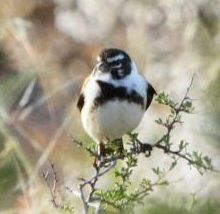| Black-headed canary | |
|---|---|
 | |
| Male in Northern Cape, South Africa | |
 | |
| Female in Namaqua National Park, South Africa | |
| Scientific classification | |
| Kingdom: | Animalia |
| Phylum: | Chordata |
| Class: | Aves |
| Order: | Passeriformes |
| Family: | Fringillidae |
| Subfamily: | Carduelinae |
| Genus: | Serinus |
| Species: | S. alario |
| Binomial name | |
| Serinus alario | |
 | |
| Global range Year-Round Range Summer Range Winter Range | |
| Synonyms | |
| |
The black-headed canary (Serinus alario) is a species of finch found in Lesotho, Namibia and South Africa. It is sometimes placed in the genus Alario as Alario alario
Contents
Its habitat is dry open scrub and grassland, the edges of cultivation and suburban gardens.

